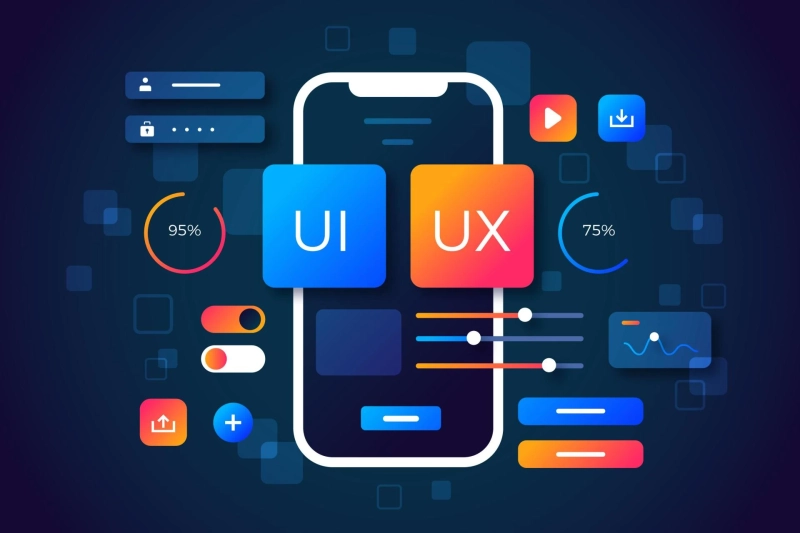In today's digital world, user interface (UI) and user experience (UX) design play crucial roles in creating successful web and mobile applications. As a beginner venturing into this exciting field, you'll need to grasp fundamental concepts, develop essential skills, and familiarize yourself with industry-standard tools. This guide will help you kickstart your UI/UX design journey, providing you with a solid foundation to build upon.
Understanding UI/UX Design
Before diving into the specifics, it's important to understand what UI and UX design entail:
User Interface (UI) Design: This focuses on the visual elements of an app or website, including layout, color schemes, typography, and interactive elements. UI designers aim to create aesthetically pleasing and intuitive interfaces.
User Experience (UX) Design: This encompasses the overall experience a user has with a product. UX designers focus on user research, information architecture, usability, and creating seamless user journeys.
While these disciplines are distinct, they often overlap and complement each other in the design process.
Essential Skills for UI/UX Designers
To excel in UI/UX design, you'll need to develop a diverse skill set:
Visual Design: Master the principles of color theory, typography, layout, and composition to create visually appealing interfaces.
User Research: Learn to conduct user interviews, surveys, and usability tests to gather insights about your target audience.
Information Architecture: Develop the ability to organize and structure content in a logical, user-friendly manner.
Wireframing and Prototyping: Create low-fidelity sketches and interactive prototypes to visualize and test your designs.
Interaction Design: Understand how users interact with digital products and design intuitive, responsive interfaces.
Empathy: Cultivate the ability to put yourself in the user's shoes and design with their needs and preferences in mind.
Analytical Thinking: Develop problem-solving skills and learn to make data-driven design decisions.
Communication: Hone your ability to present and defend your design choices to stakeholders and team members.
Getting Started with UI/UX Design
Now that you understand the core skills required, here are some steps to begin your UI/UX design journey:
Study Design Principles: Familiarize yourself with fundamental design concepts such as balance, contrast, hierarchy, and whitespace. Resources like "The Non-Designer's Design Book" by Robin Williams can be invaluable for beginners.
Learn from Existing Designs: Analyze successful websites and apps to understand what makes them effective. Platforms like Dribbble and Behance showcase professional designs and can serve as inspiration.
Practice Sketching: Start by sketching your ideas on paper. This low-tech approach allows you to quickly iterate on concepts without getting bogged down in details.
Master the Tools: Invest time in learning industry-standard design tools (more on this later).
Build a Portfolio: Create personal projects or redesign existing websites/apps to showcase your skills and thought process.
Essential Tools for UI/UX Designers
Familiarizing yourself with the right tools is crucial for efficient and effective design work. Here are some essential tools for UI/UX designers:
Sketch: A vector-based design tool popular among UI designers for its intuitive interface and extensive plugin ecosystem.
Figma: A collaborative design tool that allows real-time collaboration and works across different platforms.
Adobe XD: Part of the Adobe Creative Suite, XD offers powerful prototyping and collaboration features.
InVision: A prototyping tool that allows you to create interactive mockups of your designs.
Axure RP: Ideal for creating complex, highly interactive prototypes.
Designing for Web vs. Mobile
While many principles of good design apply to both web and mobile applications, there are some key differences to keep in mind:
Web Design Considerations:
- Larger screen sizes allow for more content and complex layouts
- Navigation is typically more expansive
- Hover states can be utilized for additional interactivity
Mobile Design Considerations:
- Limited screen real estate requires prioritizing content
- Touch-based interactions necessitate larger tap targets
- Gestures (swipe, pinch, etc.) offer additional ways to interact
- Consideration for one-handed use and thumb-friendly zones
Best Practices for UI/UX Design
As you embark on your design journey, keep these best practices in mind:
Prioritize Usability: Ensure your designs are intuitive and easy to navigate.
Maintain Consistency: Use consistent design elements throughout your interface to create a cohesive experience.
Embrace Simplicity: Avoid clutter and unnecessary complexity in your designs.
Design for Accessibility: Consider users with disabilities and ensure your designs are inclusive.
Use Visual Hierarchy: Guide users' attention to the most important elements through size, color, and placement.
Continuing Your UI/UX Design Education
The field of UI/UX design is constantly evolving, so continuous learning is essential. Here are some ways to further your education:
Online Courses: Platforms like Coursera, Udacity, and Interaction Design Foundation offer comprehensive UX design courses.
Design Bootcamps: Intensive programs that provide hands-on experience and portfolio-building opportunities.
Design Books: "Don't Make Me Think" by Steve Krug and "About Face" by Alan Cooper are must-reads for aspiring UX designers.
Industry Conferences: Attend events like UXPA International and Interaction to network and learn from industry leaders.
Design Challenges: Participate in design challenges on platforms like Dribbble or Daily UI to practice your skills regularly.
Conclusion
Embarking on a career in UI/UX design can be both exciting and challenging. By focusing on developing essential skills, mastering the right tools, and continuously learning and adapting, you'll be well on your way to creating impactful digital experiences. Remember, great design is about solving problems and creating value for users. As you progress in your journey, always keep the end-user at the center of your design process, and you'll be sure to create meaningful and successful products.
Devoq Design Company is a leading UI/UX Design Agency in Port Hedland and UI/UX Design Agency in Broome, offering bespoke design solutions tailored to the unique needs of businesses in these regions. With a focus on creating user-friendly and visually captivating interfaces, Devoq Design Company helps clients in Port Hedland and Broome achieve exceptional digital experiences and enhanced user engagement.



